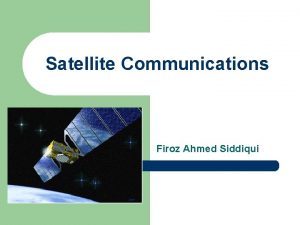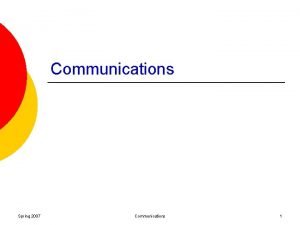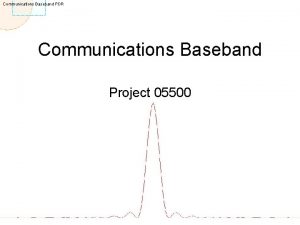Satellite communications What is Satellite A satellite is











- Slides: 11

Satellite communications

What is Satellite? A satellite is a solid object which revolves around some heavenly body due to effect of gravitational forces which are mutual in nature. Communication Satellite A communication satellite is an artificial satellite that act as a radio relay station in orbit above the earth that receives, amplifies and redirects analog and digital signals carried on a specific radio frequency. It act as a repeater in long distance communication path. Evolution of Satellite Communication: During early 1950 s, both passive and active satellites were considered for the purpose of communications over a large distance. Passive satellites though successfully used in the early year of satellite communications, with the advancement in technology active satellites have completely replaced the passive satellites.

Passive Satellites: A satellite that only reflects signals from one Earth station to another or from several Earth stations to several others. It reflects the incident electromagnetic radiation without any modification or amplification. It can't generate power, they simply reflect the incident power. The first artificial passive satellite Echo-I of NASA was launched in August 1960.

Disadvantages: v Earth Stations required high power to transmit signals. v. Large Earth Stations with tracking facilities were expensive. v. A global system would have required a large number of passive satellites accessed randomly by different users. v Control of satellites not possible from ground. v. The large attenuation of the signal while traveling the large distance between the transmitter and the receiver via the satellite was one of the most serious problems.

Active Satellites: In active satellites, it amplifies or modifies and retransmits the signal received from the earth. Satellites which can transmit power are called active satellite. Have several advantages over the passive satellites. Require lower power earth station. Not open to random use. Directly controlled by operators from ground.

Disadvantages: v. Requirement of larger and powerful rockets to launch heavier satellites in orbit. v. Requirement of on-board power supply. v. Interruption of service due to failure of electronics components

How a satellite works A satellite is a body that moves around another body in a particular path. A communication satellite is nothing but a microwave repeater station in space. It is helpful in telecommunications, radio and television along with internet applications. A repeater is a circuit, which increases the strength of the received signal and then transmits it. But, this repeater works as a transponder. That means, it changes the frequency band of the transmitted signal from the received one.

The frequency with which, the signal is sent into the space is called as Uplink frequency. Similarly, the frequency with which, the signal is sent by the transponder is called as Downlink frequency. Uplink frequency is the frequency at which, the first earth station is communicating with satellite. The satellite transponder converts this signal into another frequency and sends it down to the second earth station. This frequency is called as Downlink frequency. In similar way, second earth station can also communicate with the first one. The process of satellite communication begins at an earth station. An installation is designed to transmit and receive signals from a satellite in an orbit around the earth. Earth stations send the information to satellites in the form of high powered, high frequency (GHz range) signals. The satellites receive and retransmit the signals back to earth where they are received by other earth stations in the coverage area of the satellite. Satellite's footprint is the area which receives a signal of useful strength from the satellite.


Advantages and Disadvantages of Satellite Communication The following are the advantages of using satellite communication: v. Area of coverage is more than that of terrestrial systems v. Each and every corner of the earth can be covered v. Transmission cost is independent of coverage area v. More bandwidth and broadcasting possibilities Disadvantages of using satellite communication v. Launching of satellites into orbits is a costly process. v. Propagation delay of satellite systems is more than that of conventional terrestrial systems. v. Difficult to provide repairing activities if any problem occurs in a satellite system. v. Free space loss is more. There can be congestion of frequencies.

2. 5 Application of Satellite Communication v. Radio broadcasting and voice communications v. TV broadcasting such as Direct To Home (DTH) v. Internet applications such as providing Internet connection for data transfer, GPS applications, Internet surfing, etc. v. Military applications and navigations v. Remote sensing applications v. Weather condition monitoring & Forecasting
 Dave's satellite communications
Dave's satellite communications Iso networking standards
Iso networking standards Mkt-427
Mkt-427 Advertising and marketing communications
Advertising and marketing communications Unified communications evolution
Unified communications evolution European communications office
European communications office Icu zambia assignments
Icu zambia assignments Idaho state ems
Idaho state ems Who are puma unified communications
Who are puma unified communications Subsea wireless communications
Subsea wireless communications Precast concrete utility vaults
Precast concrete utility vaults Intelligent communications alliance
Intelligent communications alliance





















